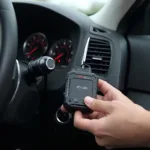Are OBD2 ports universal sized? This is a common question for car owners new to the world of onboard diagnostics. Understanding OBD2 port standardization is crucial for selecting compatible diagnostic tools and accessing your vehicle’s data.
While the term “universal” might suggest complete uniformity, the reality is a bit more nuanced. The OBD2 standard, officially known as SAE J1962, defines a standardized 16-pin trapezoidal connector, and this is the most common type you’ll encounter. This connector ensures that your elm327 bluetooth obd2 obdii car code scanner or other diagnostic tools will physically plug into your vehicle’s OBD2 port. However, there can be slight variations in the surrounding plastic housing depending on the car manufacturer.
Understanding OBD2 Port Standardization
The OBD2 standard mandates the connector’s physical characteristics and pin assignments. This standardization ensures interoperability between different scan tools and vehicles. This means a scan tool designed for OBD2 should work on any OBD2 compliant vehicle, regardless of the make or model.
Are There Exceptions to the OBD2 Standard Size?
While the 16-pin connector itself is standardized, some pre-OBD2 vehicles or those from certain manufacturers might use different connectors. These are typically older models or vehicles not sold in regions where OBD2 is mandated. Adapters are often available to bridge this gap, allowing you to use a standard OBD2 scan tool.
Are all OBD2 ports in the same location? Not exactly. The OBD2 standard specifies that the port should be located within two feet of the steering wheel, but the exact position can vary considerably. It could be under the dashboard, behind a panel near the center console, or even in the glove compartment.
Why is OBD2 Port Standardization Important?
Standardized OBD2 ports have revolutionized vehicle diagnostics and repair. They provide a single point of access for retrieving diagnostic trouble codes (DTCs), monitoring engine performance, and accessing a wealth of other vehicle data. This standardization simplifies the process for mechanics and car owners alike, making diagnostics more efficient and cost-effective.
Benefits of a Universal OBD2 Port:
- Simplified Diagnostics: Mechanics can easily connect their scan tools to any OBD2 compliant vehicle.
- Cost-Effective Repairs: Faster diagnostics can lead to quicker and less expensive repairs.
- Empowered Car Owners: best bluetooth obd2 scan tool iphone allow car owners to monitor their vehicles and potentially identify issues early.
- Improved Vehicle Emissions Control: OBD2 plays a crucial role in monitoring and controlling vehicle emissions, contributing to a cleaner environment.
“The OBD2 standard has dramatically improved the efficiency of vehicle diagnostics. The universal connector is a key part of this, allowing for seamless communication between vehicles and diagnostic tools,” says John Smith, Automotive Engineer at Acme Motors.
Finding and Accessing Your OBD2 Port
Locating your vehicle’s OBD2 port can sometimes be a bit of a treasure hunt. Check your owner’s manual, as it should indicate the port’s location. Alternatively, online resources and forums specific to your car’s make and model can be helpful.
What if I Can’t Find My OBD2 Port?
If you’re having trouble locating your OBD2 port, consider consulting a mechanic or checking online forums for your specific car model. You can also find helpful information regarding obd2 dimensions on our site. Finding the right tools can be a challenge, but our page on the best and cheapest obd2 scanners can provide valuable assistance.
“A standardized connector is crucial for ensuring that anyone, from a professional mechanic to a DIY enthusiast, can easily access vehicle data,” notes Sarah Jones, Lead Technician at Diagnostic Solutions Inc.
Conclusion
Are OBD2 ports universal sized? The answer is generally yes, referring to the 16-pin connector itself. While minor variations in the surrounding housing might exist, the standardized connector ensures compatibility across a vast range of vehicles and scan tools. This standardization has significantly improved vehicle diagnostics and empowers car owners to take a more active role in maintaining their vehicles.
FAQs
- What does OBD2 stand for? On-Board Diagnostics, Second Generation.
- Is OBD2 mandatory? Yes, in most vehicles sold in the US, Europe, and other regions since the mid-1990s.
- Can I use any OBD2 scanner on my car? Generally yes, if your car is OBD2 compliant.
- What information can I get from the OBD2 port? DTCs, engine performance data, emissions data, and more.
- What if my car has a different connector? Adapters are often available.
- Where can I find my car’s OBD2 port? Consult your owner’s manual or online resources.
- Why is my OBD2 scanner not working? Ensure compatibility and proper connection.
Need Help? Contact us via WhatsApp: +1(641)206-8880, Email: [email protected], or visit us at 789 Elm Street, San Francisco, CA 94102, USA. Our customer service team is available 24/7.

